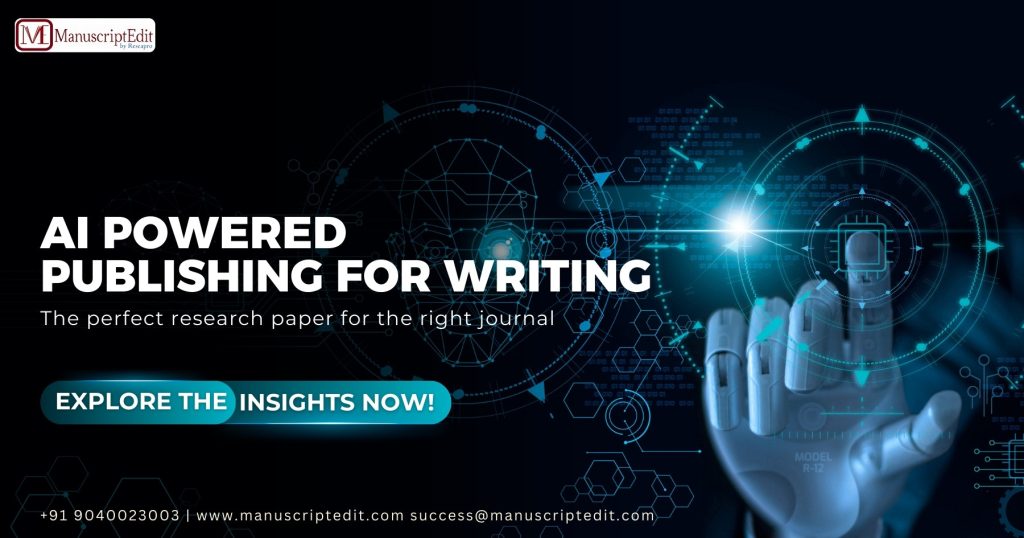|
Getting your Trinity Audio player ready...
|

The journey from developing a research idea to publishing it in an esteemed journal is both arduous and rewarding. Academic scholars and academicians face challenges in manuscript preparation, selecting an appropriate journal, and undergoing peer review. To make this smoother, making the most of the innovations such as AI-powered publishing, preprint approach, and predictive analysis of journal acceptance will likely maximize the chances of successful publication.
Table of Contents
AI-Powered Publishing: The Challenges of Academic Publishing
Publishing research is not just writing a paper; it involves adhering to journal guidelines, structuring the manuscript correctly, and ensuring it meets academic integrity standards. Some of the key challenges that researchers encounter are:
• Finding the Right Journal: With thousands of journals available, selecting the right one can be daunting. Most researchers struggle to find a journal with reasonable acceptance rates and high relevance to their research area.
• Complying with Journal Guidelines: Organization, format, and citation styles vary significantly between journals. NLP-optimized research paper structure ensures manuscripts are tailored to specific journal requirements through AI-powered publishing.
• Growing Research Visibility: The impact of a published article is typically measured using bibliometrics and H-index optimization through strategic publishing. Researchers need to adopt a robust publication strategy in order to boost their citations and academic reputation through AI-powered publishing.
• Conquering the Peer Review Process: Academic authors tend to get rejected due to minor errors or vagueness in their pieces. Proper peer review preparation ensures that manuscripts are expertly edited and prepared to meet the eye of the critic with the support of AI-powered publishing.
Leveraging AI and Technology for a Competitive Edge
AI development in research has changed publication in academia. Semantic analysis for journal fit of research papers is one of the tools researchers utilize to identify which journals are appropriate for their work’s scope and methodology. Blockchain in academia and interactive publications revolutionize research dissemination into accessible and open scholarly work. Publishing with AI is part of what makes this change.
Authors should also consider open-access publication to maximize their research impact. This raises visibility and encourages wider readership. Services providing journal indexing assistance can maximize discoverability and credibility through AI-powered publishing.
AI-Powered Publishing with ManuscriptEdit: The Ultimate Research Publishing Partner
Amidst these challenges, ManuscriptEdit research paper writing services offer researchers a reliable ally in academic publication. From manuscript preparation to final submission, ManuscriptEdit research paper editing by experts ensures linguistic precision, transparency, and conformity to journal specifications with the assistance of AI-powered publishing.
A few of the services that enable researchers in subtle ways are:
• Journal Selection Guidance: Employing predictive analytics for journal acceptance percentages, ManuscriptEdit helps authors achieve the best journals appropriate for their work through AI-powered publishing.
• Manuscript Structure & Format: Promoting compliance with journal specifications through NLP-tuned research paper structure, accompanied by AI-powered publishing.
• Peer Review Readiness: Assisting researchers in review readiness with ManuscriptEdit peer review readiness, accompanied by AI-powered publishing.
• Submission Support: End-to-end support via Publish with ManuscriptEdit journal submission support using AI-powered publishing.
Strategic Publishing for Optimal Research Impact
Researchers must adopt a strategic publication strategy to maximize the exposure and impact of their work. Incorporating a preprint strategy can help secure early claims on findings, and research metrics analysis can aid in discovering a study’s potential reach and impact. AI-powered publishing can make this process easier.
Also, the machine learning journal match algorithm and H-index optimization through tactical publishing facilitate scholars’ informed decision-making regarding publication. Both the above-mentioned strategies are employed to publish the research and yet further optimized by reaching the correct target population by optimizing the scholarly influence utilizing AI-powered publication.
Conclusion
Navigating the scholarly publishing world requires careful research, journal selection, and expert manuscript preparation. Using AI-powered publishing and expert services like ManuscriptEdit maximizes opportunities for publication success. Whether manuscript editing, increasing the visibility of research, or streamlining the submission process, ManuscriptEdit remains the best research publishing partner in every way. Start your journey to effective academic publishing with #ManuscriptEdit. Elevate your research with professional support and ensure your work receives the attention it’s due through AI-powered publishing.



